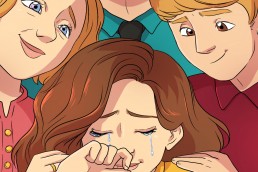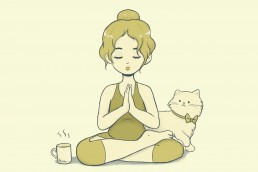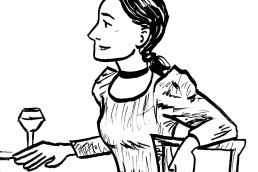Claire Heuchan
Collage: Ida Henrich
Award Winning Blogger and writer Claire Heuchan describes the work of clearing space – at home and in her head – to create a calm in creativity that consumerism never could.
Admitting there’s a problem is not always the easiest thing to do, because then you are faced with two options that are usually less than appealing. The first option is to take action and confront the issue head on, working towards change. This can be a demanding and lengthy process, depending on the problem’s nature. The second option is to do nothing and live with the dissatisfaction brought about by the problem, a pervasive sense of unhappiness likely to grow as the problem does. If, like me, you have ignored a problem, you will perhaps have wondered now and then if you aren’t being a bit of a coward. Unhappiness and doubt aren’t always enough to make a person deal with a problem, especially if it exists as part of a cycle they don’t know how to break. But sometimes the balance tips, something vital shifts within us, and change feels possible in a way that it did not before.
Last December, enervated by a recent round of mental health workshops, I decided to tidy my room. The final session invited participants to think about what one thing, within our power to change, could make us happier. And the thought crystallised: I should tidy my bedroom. That sounds like a straightforward enough task, something that might take a few hours – a chore that a child could do. And yet I never could.
When I was a kid, my messiness exasperated my family. There were endless entreaties to tidy my room. But I didn’t have the words to explain the well of emptiness and desperation that grew in me, the feeling that everything was slipping through my fingers faster than I could catch hold of it and put it all back together. Looking back, the mess was the earliest outward manifestation of my depression. It was as though I was moving through molasses while the world around me spun twice as fast, and the mess – like everything else – got away from me. Eventually, my mother and my grandparents gave up.
The state of my bedroom became something of a family joke. Until the end of his life, my grandfather described it as a bombsite, a dump, a sinkhole. And my room felt like all three rolled into one. The longer it went on, the more junk I accumulated. The more of it there was, the less possible doing anything about it felt. Surviving from day to day, especially during the drawn out depressive 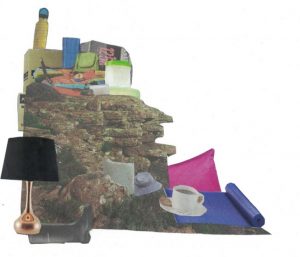 episodes, already took up so much energy that I could no more have tackled the mess than swam across the Atlantic Ocean. During especially bad times, there have been many days when simply not self-harming has demanded every last bit of my focus. So the mess fed on my depression, expanding until it covered every available surface and filled every last corner.
episodes, already took up so much energy that I could no more have tackled the mess than swam across the Atlantic Ocean. During especially bad times, there have been many days when simply not self-harming has demanded every last bit of my focus. So the mess fed on my depression, expanding until it covered every available surface and filled every last corner.
It wasn’t a good way to live but it was, at least, living. I often felt indifferent to the mess in my living space, having grown habituated to it over time – hideous as it was, all that mess made up my normal. When the depression lifted, I’d occasionally be filled with horror at the garbage heap I was living in. Not often, though. When simple things like washing and eating regularly became Herculean tasks, it is not easy to keep on top of anything beyond literal necessities. The world narrows in scope. Tunnel vision sets in. When you are in survival mode, the basics set the limits of what can and will get done.
For the longest time, I held onto things that commemorated experiences I’d enjoyed – ephemera and mementos that were never meant to be kept – in the hope I could also keep hold of some of the happiness they had come to represent. From pirate flags to place settings, I hoarded all of that shit. A stained doily from my great-grandmother’s house, toys I have not played with for two decades, train tickets, bits of broken jewellery, endless plastic bags from when I visited the Wizarding World of Harry Potter, newspaper articles, old figure skates – these were just the tip of the iceberg, all of it covered in a thick layer of dust.
The situation declined further still when, (not so) flush with student loan, I had decided that buying things to fill the void was the answer to all of my problems. Crushing weight of sadness? Buy shit! Relentless existential dread? Buy shit! Isolated and lonely? Yes, you have guessed it: buy more shit! In my defence, this is exactly the kind of behaviour encouraged by the relentless advertising of a consumer capitalist society. Yet no shiny new thing ever made me feel better. It didn’t make me happy – quite the opposite.
The more stuff sat in my room, clogging drawers and falling out of overstuffed wardrobe shelves, the more trapped I felt. Surrounded by mountains of miscellaneous crap, I did not take joy in the countless things that I owned but instead felt that they had come to own me. They restricted me physically, making it impossible to use my room for almost any purpose other than sleeping, but they also restricted me mentally, keeping me from imagining any other way of life. A well-organised, clean bedroom felt as far away as Jupiter. But I am so nearly there.
Those mental health workshops did me a world of good. Run by a community support team, they gave me the space to think about why I didn’t leave the house regularly and got me to a weekly crochet group. Not only am I well on my way to becoming a crochet master, but I have established an exercise routine and learned to cook food that is not just tasty but nutritious enough to satisfy my body’s cravings. The workshops taught me how to be present in myself without numbing tactics, and as I began to live more consciously in my body it was impossible not to notice the mess that surrounded me.
William Morris once wrote that “if you want a golden rule that will fit everything, this is it: Have nothing in your houses that you do not know to be useful or believe to be beautiful.” These, I decided, were words to live by. Only things that were useful to me or beautiful to behold could stay. Briefly, I considered spending part of my next book advance on one of those professional declutterers 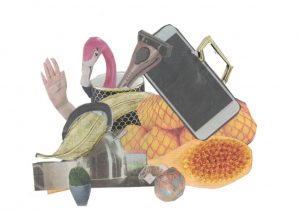 to deal with the mess. But I didn’t relish the thought of a stranger seeing this part of my life, and more than that, felt like the change wouldn’t last unless I cultivated the habit of tidiness myself.
to deal with the mess. But I didn’t relish the thought of a stranger seeing this part of my life, and more than that, felt like the change wouldn’t last unless I cultivated the habit of tidiness myself.
The process has been difficult. Six months in, and I’m still clearing crap out. It’s never pretty. There was no glamour in commando crawling through dust bunnies and used tissues to get far enough under my bed to haul out endless boxes of things I hadn’t used in years. Even after countless bags have been dropped off at the dump or delivered to the charity shop, there is still more. And yet, slowly but steadily, I am gaining ground on the mess. The pile of things that go from bed to chair when it shifts from day to night is falling away to nothing. My wardrobe and shelves are clear enough to be functional again. The avalanche of rubbish spilling from my desk is gone. The persistent odour of dust has faded, too, with thorough vacuuming. One thing I have not lost is the memories I used to keep talismans for – those pockets of joy are still there for me to dip into whenever they’re needed.
Sorting through and discarding two decades’ worth of dysfunction is no picnic, and at points the sheer volume of clothes and films and leaflets and jewellery is overwhelming. I play old favourites on Netflix in the background as I go, one of which is the TV series Bojack Horseman. As well as having sharp social commentary, a gorgeous illustration style, and unrivalled wordplay, it also offers an unflinching look at the realities of mental illness. The protagonist, Bojack, is a depressive with highly dysfunctional behaviour that leads to the sort of antics ideal for a black comedy. His self-loathing is fuelled by the fear that he will never reach the heights of his former success as an actor. Despite (or perhaps because of) his fame, wealth, and influence, Bojack is miserable. Bojack believes that he was born broken, that life will never get better, and uses this fatalism to justify his destructive tendencies. The people in his life are having none of it and remind Bojack repeatedly that he needs to do better, both for himself and others.
Those reminders that change is possible, along with therapy and community support, shifted the way I’d fallen into thinking about my own depression. There is no miracle cure, but I do have a degree of control over some factors that influence my mental health – including the condition of my living environment. Hard as it is, there’s a reason I keep going. As I have developed a sense of self-worth, and started to believe myself deserving of respect and care, I have come to believe that I deserve a nice living space – somewhere it’s properly fun to crochet, game on my PlayStation, listen to podcasts, and chill. And every day it gets a little bit nicer.
Claire Heuchan
Claire Heuchan is a Black radical feminist from Scotland, and author of award winning blog Sister Outrider. In addition to winning the Best Blog category for the 2016 Write to End Violence Against Women Awards and being shortlisted for the Emma Humphreys Memorial Prize, Sister Outrider is accessed around the world and has been translated into French, Spanish, Portuguese, German, and Dutch.
Claire achieved an MLitt in Gender Studies at the University of Stirling, which informs her theorising alongside 25 years of experience inhabiting this world in a body that is Black and female. Claire has essays featured in a growing range of books, and is a volunteer at the Glasgow Women’s Library.
Ida Henrich is a German Cartoonist, Illustrator and Designer based in Scotland. She has worked with award winning publishers, online coaches and magazines. Ida is a graduate of Communication Design at the Glasgow School of Art where she specialised in Illustration. In her own work she explores themes such as sex-education, growing up, and women’s experiences. Her comics and illustrations are written for both men and women and aim to start an open dialogue between partners, friends, parents, and children about their experiences. Ida believes that Art is a powerful way to make ideas and feelings tangible.
As Art Editor at Fearless Femme, Ida is responsible for all things visual, including the correspondence with our visual artists, the design and realisation of the online magazine and the illustration of our amazing cover women. She also creates artwork for some of our articles, poems and stories.
Ida loves her coffee in the morning, that feeling after finishing an illustration and going for a run in the (Scottish) sun; and pilates on the rainy days. Ida enjoys SciFi books and autobiographies, and autobiographical comics. She is always delighted to meet new people on trains but is also smitten being home alone colouring in an illustration that she has made way too intricate while listening to Woman’s Hour. You can contact her at ida@fearlessly.co.uk.




